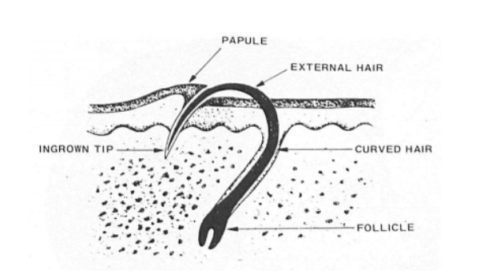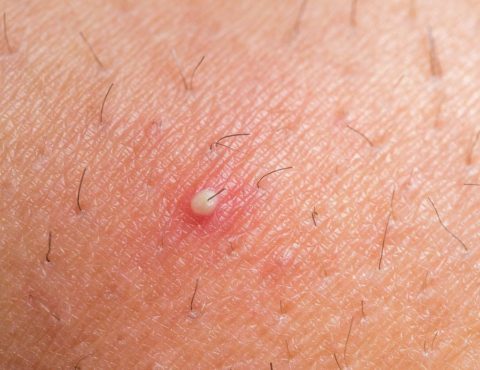
Frequently associated with shaving, ingrown hairs occur when growing hairs curl back into the skin. This causes the formation of round bumps and pustules that may become infected. Major complications are rare, and ingrown hairs are treated in a variety of ways. Read on to learn more about how to avoid and treat ingrown hairs, and what can go wrong.
What Are Ingrown Hairs?
After shaving, short, sharp, and pointed hairs grow out from under the skin. These become ingrown hairs (also known as Pseudofolliculitis barbae) if they grow back into the skin, slightly penetrating the outer skin layer (epidermis). This happens close to the hair follicle, forming dimples, as seen in the figure below [1].

Ingrown hair scheme from Braunet
Hair can reenter the skin in 2 ways:
- The sharp tip of the hair reenters the skin close to the follicle [1].
- The shaved hair retracts back directly into the follicle and then goes into the deeper skin layer (dermis) [1].
Round bumps and small blisters with pus (pustules) may appear at the ingrown site because the ingrown hair triggers the foreign body inflammatory response [2].
Ingrown hairs are most common in individuals of African ancestry (82% versus 18% in Caucasians). In fact, over 50% of men with African ancestry struggle with ingrown hairs [3, 4, 2].
Infected Ingrown Hairs
Bacterial infections sometimes occur, worsening inflammation and causing pustules. In these cases, an antibiotic cream may be useful (applied on pustules 1 to 2 times daily) [5, 1].
Ingrown Hair Causes
Rapid hair growth (body or facial) and curly hair are common risk factors for ingrown hairs. These may be influenced by genetics or hormonal disorders [6, 7].
Some people have genetic mutations in a gene for hair proteins (keratin) in follicles, which increases their risk of ingrown hairs [8].
Ingrown Hair Treatment
An occasional ingrown hair isn’t a cause of alarm and is normally not treated. Talk to your doctor if ingrown hairs are a chronic condition in your case. They may prescribe medications such as [9, 1, 4]:
- Acne cream (benzoyl peroxide), alone or with antibiotics, after shaving. This kills the bacteria and calms the skin, reducing the number of round bumps and pustules.
- Steroid cream (corticosteroids) for more severe cases (1 to 3 times a week for 2 weeks) to reduce inflammation
- Antibiotic cream applied once or twice daily if there is an infection
- Vitamin A cream (retinoids) improves the lesions caused by ingrown hairs, helps to prevent scarring, and regenerates the skin.
- Bleaching preparations prevent scarring and tone the skin.
- A glycolic acid lotion is very effective at treating ingrown hairs by softening the skin while allowing men to still shave every day.
Numerous permanent hair-removal (depilation) procedures can also prevent or treat ingrown hairs, including [9, 1, 10, 11, 6, 12, 13]:
- Intense pulsed light (IPL) is an effective and safe method for long-term hair removal. It is especially useful for men with skin irritation and ingrown hairs.
- Laser treatment is a safe and effective option for reducing papules caused by ingrown hairs. The results last up to 3 months after treatment. It’s even more effective when used with a prescription cream that decreases hair regrowth (eflornithine hydrochloride).
- Electrolysis may work for permanent hair removal but is not recommended. It is painful, expensive, and generally ineffective in treating ingrown hairs.
- Surgical removal is possible but very uncommon.
Treatment Side Effects
This list does not cover all possible side effects. Contact your doctor or pharmacist if you notice any other side effects.
Call your doctor for medical advice about side effects. In the US, you may report side effects to the FDA at 1-800-FDA-1088 or at www.fda.gov/medwatch. In Canada, you may report side effects to Health Canada at 1-866-234-2345.
- Depilatory creams and chemicals may cause irritation, skin injury, and allergic reactions (dermatitis) [1].
- Steroid creams (topical corticosteroids) may cause skin thinning and an aged skin appearance. To minimize side effects, steroid creams should not be applied to large areas or over an extended period of time [1].
- Retinoids should be avoided during pregnancy, as they may cause birth defects [14].
Ingrown Hair Prevention
The following strategies may reduce your likelihood of ingrown hairs. Discuss with your doctor which one may be preferable in your case.
- Stop shaving. This is the most effective treatment and cures most cases after one month [1, 9].
- Wash the area with warm water and a mild soap-free cleanser before shaving [15].
- Use a clean and sharp razor [16].
- Don’t stretch the skin while shaving [17].
- Find the best direction for shaving. Shaving in the direction of hair growth is considered the best option; however, 1 study found that men shaving against the grain had fewer bumps [1].
- Shave only 2 to 3 times per week (versus daily) and with advanced shaving and skincare products that hydrate the skin to reduce ingrown hairs [18].
- Electrical razors control ingrown hairs, but research about the best shaving tools is scant (single blade vs. double blades and electric vs. manual shaves). They may be less likely to cause ingrown hairs if not set at the closest shave and held slightly away from the skin [1].
- Foil-guarded manual razors improve the condition of most patients [19, 1].
- Depilatory creams are a useful alternative to shaving. These hair-removal creams lead to fewer papules than shaving with a razor, but the post-shave irritation is more pronounced. It’s recommended to try them first on a small area to check for skin sensitivity [17].
- Hair-removal creams (such as eflornithine hydrochloride) reduce excessive hair growth and the risk of developing ingrown hairs [20, 21].
Limitations and Caveats
The majority of studies were done on people of African descent, so the results may not be applicable to everyone.
Studies comparing single-blade versus multiple-blade razors, or electric versus manual razors, are lacking. Additionally, the best direction of shaving cannot be concluded from current research.



